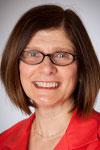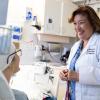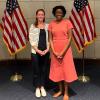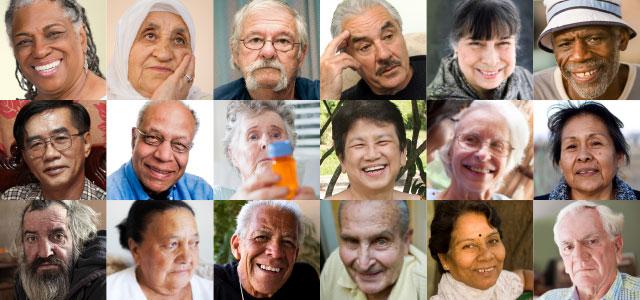
Finding and Training a Workforce That Can Address Older Adults’ Long-Term Care Needs
As baby boomers become seniors, a powerful demographic shift that’s already under way, the number of people needing care in a multitude of ways is steadily increasing. Whether it’s help with the activities of daily living such as shopping or dressing, or clinical care for a complex mix of health conditions, this aging population needs a workforce ready for the job.
To this end, UC San Francisco School of Nursing and its partners across the medical center are home to a new national research center aimed at informing policymakers about how to address this potential long-term care crisis. UCSF’s Health Workforce Research Center is one of four centers nationwide scrutinizing different aspects of the workforce needs of an aging population.
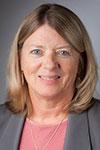 Susan Chapman Launched in September, UCSF’s center will gather and analyze data for a comprehensive examination of what’s needed to support the long-term care needs of older people. This will include the recognition that more seniors are aging at home or in community settings versus institutions.
Susan Chapman Launched in September, UCSF’s center will gather and analyze data for a comprehensive examination of what’s needed to support the long-term care needs of older people. This will include the recognition that more seniors are aging at home or in community settings versus institutions.
“Our mission is to address this one question: Is our health care workforce prepared to meet the growing long-term care needs of the US population?” says Susan Chapman, director of the School’s health policy nursing specialty and assistant director of the new research center. “UCSF has interest, experience and a deep bench in looking at issues of long-term care.”
The center’s primary collaborators are the School of Nursing, the Philip R. Lee Institute for Health Policy Studies and UCSF’s Center for the Health Professions. But the center will work closely with many other resources, including the School’s Institute for Health and Aging, its new Community Living Policy Center and the John A. Hartford Center of Gerontological Nursing Excellence; UCSF Schools of Medicine, Pharmacy and Dentistry; the Osher Center for Integrative Medicine; the UC Davis School of Nursing; and PHI (formerly called the Paraprofessional Healthcare Institute).
A Pressing Planning Need
According to the Administration on Aging in the US Department of Health and Human Services, the portion of the US population that’s age 65 or older is expected to grow to 19 percent by 2030, from 12.9 percent in 2009 – or from 39.6 million people to an estimated 72.1 million. And while in general people are living longer, the increase in age is often accompanied by an increase in disease and disability – which, in turn, increases demands on the health care system.
 Joanne Spetz Certainly, many health care experts have already been aggressively planning for this burgeoning older population. The School of Nursing, for example, has expanded clinical training to include more gerontology and has ramped up gerontological research.
Joanne Spetz Certainly, many health care experts have already been aggressively planning for this burgeoning older population. The School of Nursing, for example, has expanded clinical training to include more gerontology and has ramped up gerontological research.
Yet even with such efforts, strategic national planning is behind, says Joanne Spetz, the workforce center’s director, who is a faculty member at the School as well as a professor of economics at the UCSF Philip R. Lee Institute for Health Policy Studies.
“Generally speaking, on the fiscal and health care dimensions, the country is not well prepared for the impact of the aging baby boomers,” Spetz says. “It’s such a big population of people that is reaching the aging years at the same time.”
A National Effort
Each of the four new workforce research centers, which are funded by the Health Resources and Services Administration (HRSA), has a different specialty area, with the shared goal of providing policy-oriented data or evidence for planning. UCSF’s funding is for four years at about $400,000 a year, with a focus on long-term care, including the needs of people with disabilities unrelated to aging.
The UCSF investigators will try to shed light on such pressing questions as: How many workers and what skill sets and training are needed to provide quality care? Where and when are they needed, and at what cost?
“We’re looking across the sector of long-term care at the whole breadth of workers, from the highly skilled geriatrician or nurse practitioner to home health care workers who have received little to no training,” Chapman says.
A Push to Move Quickly to Inform Policy
Each center will complete three or four studies a year – a relatively short time frame for traditional academic research. Centers are also on call for quick-turnaround studies. Topics are chosen collaboratively, with input from an outside team of national advisors and HRSA experts.
UCSF’s first round of studies will look at:
- Training requirements for personal care aides: Should training requirements be standardized? Should there be credentials?
- Trends in long-term care service use, and workforce demand predictions.
- Sources of new workers, and job mobility in long-term care: Identify occupations from which long-term workers are drawn. Where do they go? What are the wage impacts of mobility?
The goal is to disseminate study results quickly and broadly to inform policymakers, think tanks, nonprofit advocacy organizations and media. Dissemination will occur in a variety of ways including through social media, press releases and published journal articles.
“Obviously, each study will have a somewhat different audience. I expect in the short term, state and local governments are going to be key beneficiaries. Most health workforce policy is really done at the state level,” says Spetz.
Federal budget makers, community colleges, workforce development programs and nursing home regulators, as well as key advocacy groups such as AARP and LeadingAge, are other important stakeholders, she says.
“We are providing evidence and information; we don’t lobby, but we can make policy recommendations that lobbyists may very well use to press for policy change,” Spetz says.
The Benefits of Collaboration
The center – which is virtual and therefore doesn’t have an actual office space – taps into UCSF’s long history of expertise in both the care of older patients and cross-disciplinary work. For each project, Spetz and Chapman will assemble small study teams from across the campus and will also collaborate with the other national centers housed at the University of North Carolina at Chapel Hill, The George Washington University and University at Albany, State University of New York.
“We basically cross-fertilize, which is great. [HRSA] would like to see the whole be greater than the sum of the parts,” says Spetz. “The more we can leverage and provide value for the federal dollars the government has invested, the better it is for everybody.”
Peter Buerhaus, chairman of the National Health Care Workforce Commission and director of the Center for Interdisciplinary Health Workforce Studies at Vanderbilt University Medical Center, is an expert on health care workforce projections.
“This is a wonderful and timely development,” says Buerhaus, who is also a professor at Vanderbilt’s nursing school. “This decade, unlike any time in our nation’s past, offers the opportunity to improve the delivery of health care, provide care to more people, incorporate education and prevention in the mainstream of care and change payment systems to reward value. However, fully realizing these opportunities will require a well-configured, properly sized health care workforce prepared for these changes.”
Buerhaus adds: “As health reforms unfold, having timely data and analysis of key workforce trends will be incredibly important to inform policymakers, employers and the public.”

